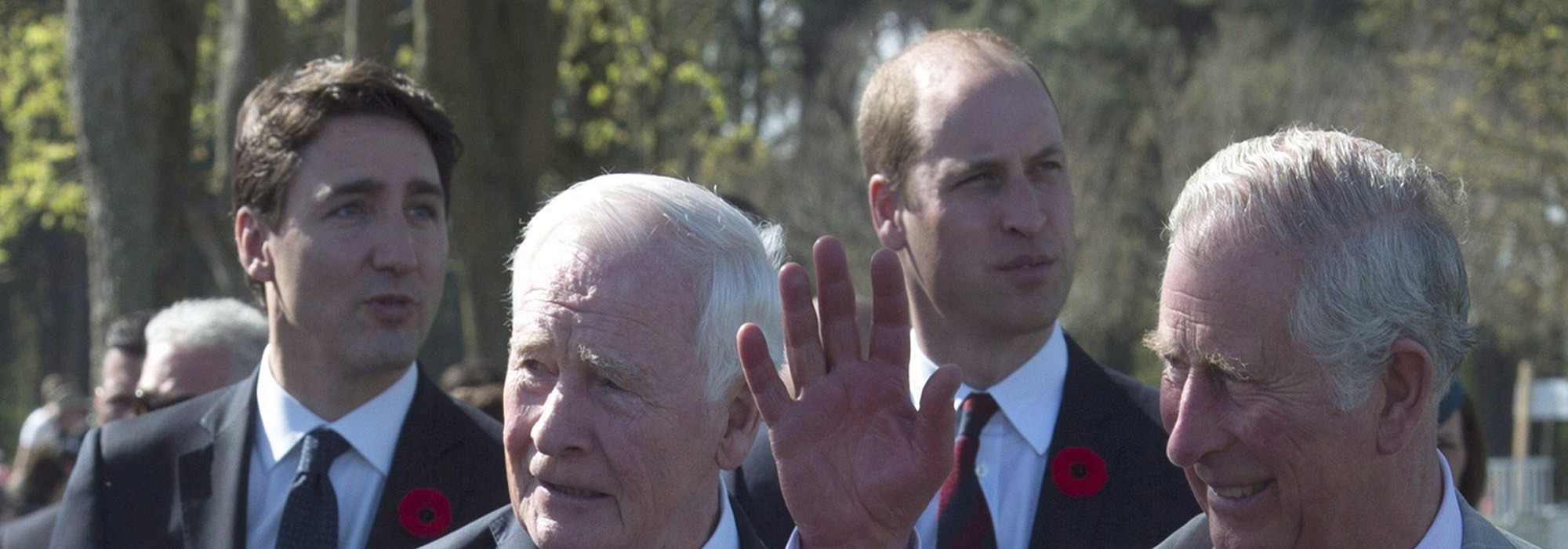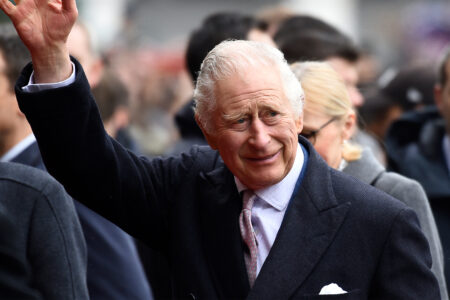
The British and Canadian monarchies are undergoing a transition. Now 91 years old, Queen Elizabeth II is cutting back on public engagements, and it’s unlikely that she’ll undertake any royal tours outside of the United Kingdom in the future. As the Queen moves toward a more forgiving schedule, her children and grandchildren are taking on many of her symbolic responsibilities, both at home and abroad.
Her apparent heir and successor, Prince Charles, will shoulder the most significant of these delegated responsibilities. Canadians saw this last month when Charles attended the Vimy commemoration. Prince Charles will also be present at this year’s Canada Day celebration in Ottawa, marking the 150th anniversary of Confederation. He may not be King of Canada yet, but he is the stand-in.
The Queen’s delegation of symbolic functions works well in the British context. The Prince of Wales has a constitutional status in the United Kingdom, and the law of royal succession provides a legal logic for delegating tasks to the Queen’s successors. In Canada, however, the Queen’s decision to assign symbolic functions to Prince Charles exposes the awkwardness of the contemporary Canadian monarchy. We’re left with ambiguity regarding what roles the Prince of Wales should play here.
Canada’s governor general is the Queen’s vice-regal representative in Canada. Legally and constitutionally, the governor general is authorized to exercise nearly all of the Queen’s powers for and in Canada. Lieutenant governors are similarly empowered in the provinces. In addition to exercising the Queen’s powers and performing the Crown’s ceremonial functions (such as the Speech from the Throne), these vice-regal officers have also taken on “communal” roles akin to those that the monarch performs in the United Kingdom, such as highlighting worthy endeavours, promoting voluntary service, and supporting charitable giving. The governor general and the lieutenant governors allow Canada to operate as an efficient and unassuming constitutional monarchy in the absence of a resident sovereign.
When the Queen has visited Canada, her role and functions haven’t required much explanation. As the personification of the Canadian state and head of state, the fount of executive authority, one part of Parliament, and the formal focus of military loyalty, pretty much anything the Queen does while in Canada can be linked to her constitutional position. Since the Queen appoints the governor general, and the governors general appoint lieutenant governors, there is no question that the sovereign outranks her vice-regal representatives. As the Queen of Canada, the constitutional basis of her visits and involvement in Canadian affairs has been evident.
The Prince and Canada
The Prince of Wales’ relationship with Canada is more complicated. On the one hand, Prince Charles is a member of the Canadian Privy Council and he is colonel-in-chief of several Canadian regiments. He founded the Prince’s Charities Canada and is patron of numerous organizations. He has a Canadian royal standard and has toured Canada many times since the 1970s, reflecting not only his standing as a member of the royal family but also his stature as a public figure and advocate of various causes. Most importantly, barring any unforeseen circumstances, he will become King of Canada when his mother passes.
On the other hand, until there is a demise of Crown (the technical term for when a monarch dies), it is not obvious what place Prince Charles occupies in the Canadian Constitution. Unlike in the United Kingdom, the Prince of Wales has no constitutional rights and duties in Canada. There is no explicit mention of the Prince of Wales in the Constitution Act, 1867 or the Constitution Act, 1982. Section 2 of the British North America Act, 1867 (now the Constitution Act, 1867), which mentioned the Queen’s heirs and successors, was repealed by the British Parliament in 1893.
Canada has no equivalent of the United Kingdom’s Regency Act, 1937, which would allow the Prince to fulfil the Queen’s functions for Canada should she be incapacitated. Oaths to the Queen and her “Heirs and Successors,” moreover, have been deemed merely symbolic by the Ontario Court of Appeal.
Were we to try to anchor the Prince of Wales in the Canadian Constitution, we would have two, albeit flawed, options.
First, we could argue that the preamble to the Constitution Act, 1867, which provides that Canada was united under the “Crown of the United Kingdom of Great Britain and Ireland, with a Constitution similar in Principle to that of the United Kingdom,” and the Statute of Westminster, 1931, which makes reference to a “common allegiance to the Crown,” connect the Prince of Wales to Canada.
But since the Statute of Westminster, 1931, the Imperial Crown has been gradually divided, such that there were separate and distinct crowns and queens for the United Kingdom, Canada, and the other dominions. If the British and Canadian crowns are now separate and distinct, the Prince of Wales can only have a constitutional status in Canada by virtue of Canadian law.
Second, we could view the Prince of Wales as inexorably tied to the Queen, as her apparent heir and successor, and hence any reference to the Queen in the Constitution makes allusion to the Prince of Wales as well.
But the Canadian government put an end to the notion of the royal line of succession being part of Canadian law in 2011. At the time, the Commonwealth heads of government had agreed to update the laws of royal succession. The purpose of these changes was to end male primogeniture and to allow a successor to the throne to marry a Catholic. Australia and New Zealand passed their own acts updating the rules of royal succession, as did the United Kingdom. Canada chose a different course. The Canadian government merely asked Parliament to assent to Britain’s new royal succession bill, which changes the law of royal succession for the United Kingdom.
Drawing on a 2003 Ontario Superior Court judgement, the government held that royal succession was not a matter of Canadian law, nor was it an issue that affected the Canadian Constitution. Instead, the government, and many influential constitutional lawyers, argued that the Canadian Constitution contains a “rule of recognition” or “principle of symmetry,” such that the sovereign of the United Kingdom is automatically the sovereign of Canada. This argument was challenged by the Quebec government and law professors from Université Laval, but the federal government’s claim was upheld in Quebec Superior Court.
This “simple rule of Crown identification,” as it has been called, operates along a single principle: that the person who is King or Queen of the United Kingdom is recognized as King of Queen of Canada. This means, in turn, that the Canadian Constitution does not need to recognize the Prince of Wales or any other of the Queen’s heirs and successors.
As far as Canada is concerned, the only member of the royal family of any constitutional standing is the monarch. Politically and culturally, of course, Canadians know that Prince Charles is the Queen’s apparent heir and successor and that he will in all likelihood be their next king. But there is nothing in the Canadian Constitution or Canadian law that identifies him as such or attributes any particular status to him as a result of his being the heir apparent in the United Kingdom.
A British prince in Canada
Hence, although Charles is expected to become of the King of Canada one day, this is only because he is the successor to the British throne. When he visits Canada, or takes part in Canadian celebrations, he does so as a British prince or as a representative of the Queen. This can become awkward when Prince Charles attends an event alongside the Governor General, as he did at the Vimy commemoration. While the Governor General was there as the Queen’s official representative, the Prince was there as her personal representative. This then raises the question: does the Queen need two representatives? And if so, how are they dividing their representative role exactly? One answer is that the Governor General was representing the Queen of Canada, while Charles was representing Elizabeth II. Unfortunately, this just creates more confusion.
Similar questions will surround Charles’ role during the Canada Day celebrations. It is difficult to see him taking on a more central role than the Governor General or the Prime Minister. As at Vimy, he will likely be squeezed between the two, in an effort to recognize his royal stature while acknowledging that the vice-regal constitutional role trumps his familial one. His speech will undoubtedly praise Canada’s achievements since Confederation and highlight his admiration for the Canadian people.
But essentially, he will be there as the successor to the British throne in accordance with British law. And in that sense, he will remind us that the Canadian monarchy remains a stunted entity 150 years after Confederation: an institution headed by the Queen of Canada, but whose rules of succession are determined by the United Kingdom.
This arrangement is awkward, but it’s the state of our monarchy today.
Photo: Prince Charles waves to spectators as he walks with Governor General David Johnston, Canadian Prime Minister Justin Trudeau, Prince William and Prince Harry as they arrive at the Vimy Ridge monument near Arras, France, Sunday, April 9, 2017. THE CANADIAN PRESS/Adrian Wyld
Do you have something to say about the article you just read? Be part of the Policy Options discussion, and send in your own submission. Here is a link on how to do it. | Souhaitez-vous réagir à cet article ? Joignez-vous aux débats d’Options politiques et soumettez-nous votre texte en suivant ces directives.







